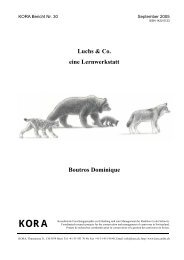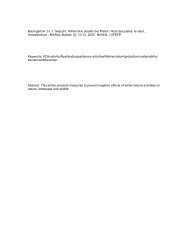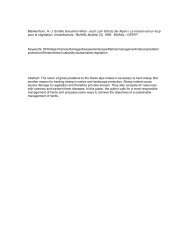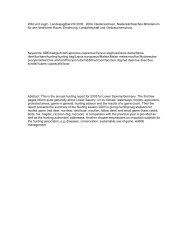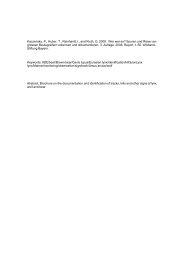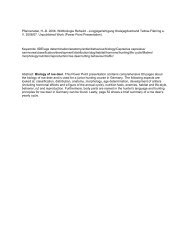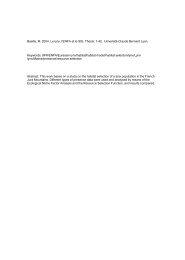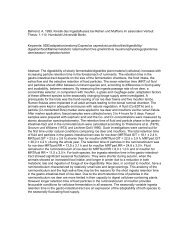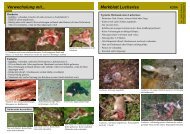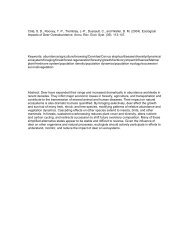8 Material and Methods / ResultsKORA <strong>Bericht</strong> Nr. 13Nikon SB-15 flesh and the film a Kodak ProfessionalPORTRA, ISO 160vc, 135mm. I took pictures from thefollowing body/coat areas: left and right, shoulder/upper arm, forearm, hand, femur/hip, lower leg, foot,flank and dorsum and the complete left and right side.The pictures were made in daylight. All pictures werescanned and saved in a jpg-format. From Collaboratorsin Slovakia, Slovenia and Croatia I had alreadyscanned pictures saved in a jpg-format.2.2. Classification of Coat PatternsI intuitively deducted 5 different coat pattern types:type 1 as “large spots”; type 2 as “small spots”; type 3as “without spots” and two types of rosettes: type 4a as“clear rosettes” and type 4b as “spots with rudimentaryrosettes” and chose typical representatives of everytype.To describe these 5 types I counted the number ofspots on 6 selected areas of the body surface, accordingto anatomical criteria: left/right, shoulder, upper armand forearm (L/R1); left/right flank and back (L/R2),left/right femur, hip and lower leg (L/R3) (Figure 1). Inthis areas the typical coat pattern type was represented.The area next to the backbone and the ventral-side(white coat color) depending on the posture of the individual,was not visual on several pictures. So I did notuse these areas for analyses. Spots were counted afterdefined rules. Large or small spots: every identifiablesingle spot and spots in V-form were counted as onespot. Spots in rosettes or in rudimentary rosettes: everyidentifiable spot arranged in rosettes/small blotcheswas counted as one spot. Spots arranged in groups:every identifiable spot arranged in strips or other arrangementswas counted as one spot. Strips where nointerception was identifiable was counted as one spot.Coats without spots: no counting of spots (AppendixIII). To verify the measurements and countability ofcounting the first 10 objects I counted three times andcalculated the mean value. Also coats with undistinguishableor bleached patterns I counted three times.As reference to the degree of bleaching of pattern Iused the black tail color and its degree of bleaching. Todistinguish between large and small spots I randomlymeasured the diameter of 10 spots (randomly distributedover the body) of 12 individuals, 6 typical largeand 6 typical small spots and calculated the meanvalue.2.3. Evaluation and statistical analysesThe differences in number of spots in the six body/coatarea were tested by Kruskal-Wallis-Test. The Principal-Component-Analysiswas used to test differencesbetween the coat pattern types based on the total numberof spots and the existence of rosettes. To comparedata of the five populations (historical and recent SwissAlps, Jura Mts, Slovakia, Slovenia/Croatia) I used theχ-square-test. For tests of normality I used the Kolmogorov-Smirnov-test.Figure 1. The six selected areas of the body/coat (dotted areas):left/right, shoulder, upper arm and forearm (L1/R1);left/right flank and back (L2/R2) and left/right femur, hipand lower leg (L3/R3).All available lynx were assigned after a createdpath-diagram based on the description of the five differentcoat pattern types. To evaluate the spatial distributionI only used individuals with known location(last origin, place of caught/found/dead, coordinates ofcaught/found) and for temporal analyses individualswith known year of birth.3. Results3.1. Identification of coat pattern typesFrom 148 individuals, I counted the number of spots insix different body/coat areas. This method proved to beuseful and applicable. The mean value was calculatedof the same area between the left and right side([L1+R1]/2, [L2+R2]/2, [L3+R3]/2) and the total numberof spots of every individual.The number of spots per body/coat area of type 1and 3 were significantly different to all other types(Mann-Whitney-U-test, P < 0.1, bilateral) and also betweeneach other. Type 2, 4a and 4b were significantlydifferent to type 1 and 3 but tested against each otherthere was no significant difference between the numberof spots per body/coat area (Mann-Whitney-U-test, P >0.1, bilateral) (Table 2, Figure 2). To distinguish betweenthe five different types another criterion wasneeded: the Principal-Component-Analysis assorted theindividuals in groups which showed the intuitive deductedcoat pattern types, based on the total number ofspots per individual and the existence of rosettes. Thefirst principal component explained 82.76 % of varianceand the second 6.58 % (Figure 3). The untypicalallocations showed juveniles which have less spots accordingtheir smaller bodies. One untypical allocatedtype 3 showed an individual which had no spots onshoulders, flanks and hips but more than the average onthe upper arms, femurs and legs.
Juni 2002 Results9Table 2. Statistical analysis of the total number of spots per coat pattern type (n = 148).Coat pattern type Median 25% Quartile 75% Quartile min maxType 1 316.50 294.00 349.75 130.00 430.00Type 2 528.00 477.00 660.00 309.00 812.00Type 3 183.50 136.50 219.00 84.00 492.00Type 4a 630.00 586.00 714.00 335.00 812.00Type 4b 581.00 520.00 648.00 168.00 804.00number of spots per body area160.00100.0050.000.00Type 1 L/R1Type 1 L/R2Type 1 L/R3Type 2 L/R1Type 2 L/R2Type 2 L/R3Figure 2. Number of spots per body/coat area of the fivecoat pattern types (L1/R1: left/right shoulder, upper arm andforearm; L2/R2: left/right flank and back; L3/R3: left/rightfemur, hip and lower leg, Figure 1).With all this information the five coat pattern typeswere consequently definitively defined (Table 3): type1 with large spots (Figure 4), type 2 with small spots(Figure 5), type 3 without spots on shoulders, flanksand hips but spots on upper arms, femurs and legs(Figure 6). In type 4 (rosettes) I distinguished twotypes: type 4a with clear rosettes or small blotches(single spots were no more visual and the rosettesshowed circle-forms) (Figure 7) and 4b with smallspots and rudimentary rosettes (single spots were visualwithin rosettes) (Figure 8). The definition containedsize, form, number, color and distribution of spots inthe following body/coat areas: shoulder / upper arm,forearm, hand, femur / hip, lower leg, foot, flank anddorsum.3.2. Assignment of coat pattern typesTo assign all available individuals to one of the fivecoat pattern types it was important to look at all body/coat areas. Each coat pattern type showed variation andonly the analysis of the complete body allowed the assignmentto one type. According to the analysis ofnumbers of spots and the definition of types I created apath-diagram (Figure 9). First question: “are spots vis-Type 3 L/R1Type 3 L/R2Type 3 L/R3Type 4a L/R1Type 4a L/R2Type 4a L/R3coat pattern type and body areaType 4b L/R1Type 4b L/R2Type 4b L/R3ual on flanks or not?” (type 3 can be separated from theother four types); second question: “are rosettes identifiableor not?” (type 1 and 2 can be separated fromtype 4a and 4b). The question decision is between type1 and 2, concerns the size and number of spots and betweentype 4a and 4b about the clearness of rosettes.From a total of 342 individuals, 4 individuals (1.2%)could not be assigned to one of the five types. Betweenfemales (n = 70) and males (n = 53) (unknown n = 28)(df = 4, χ 2 = 2.6, P > 0.5) and young (juveniles &subadults, n = 55) and adult (n = 82) (unknown n= 14)animals (df = 4, χ 2 = 1.89, P > 0.5) there was no significantdifference. Consequently all individuals werepooled, including those with unidentifiable age andsex.3.3. Distribution of the different coat pattern typesData from six different populations were available(historical Swiss population, n = 21; recent populationof the Swiss Alps, n = 128; Jura Mts population, n =44; Slovakian population, n = 47; Slovenian population,n = 22; Croatian population, n = 45; total individuals:306, from 32 of total 338 assigned individualsno location data were available or they originated fromzoo populations, which I did not use). Lynx from Sloveniaand Croatia belong to the same re-introducedpopulation. As the occurrence of different coat patternsdid not differ between the two subsamples ( df = , χ 2 =5.52, P > 0.05), these animals were subsequentlypooled. Rosettes have shown up only in recent populations.However, coat pattern type 4a and 4b have onlyreached a considerable proportion in the re-introducedpopulation in the Alps (46% vs. 18-28%). For furtheranalyses type 4a and 4b were also pooled to “type 4”.The animals re-introduced into Switzerland and Slovenia/Croatiaoriginated from the same source populationin the Carpathian Mts of Slovakia. The comparisonbetween the source population in Slovakia and there-introduced population in the Jura Mts (df = 3, χ 2 =5.01, P > 0.05) and the population in Slovenia/Croatia(df = 3, χ 2 = 2.96, P > 0.05) showed a similar occurrenceof the four different coat pattern types (Figure10). In all three populations type 1 was dominant (over60%). Type 4 was represented between 18-28% andType 2 and 3 about 10%. A different development wasfound in the population of the Swiss Alps (df = 3, χ 2 =8.58, P < 0.05). Predominant was type 4 (46%). Type 1



